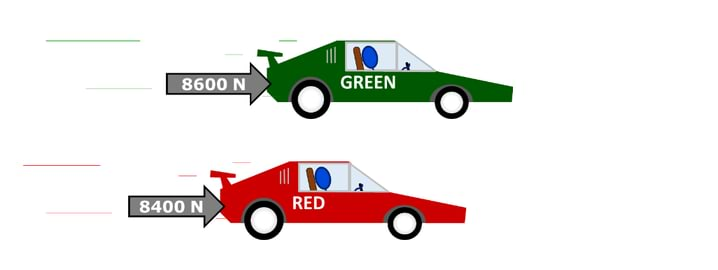Learning focus: | A resultant force on an object can cause it to speed up or slow down, depending on the direction of the force. |
Observable learning outcome: | Describe how quickly the speed of an object can be changed if acted on by resultant forces of different size. |
Question type: | Simple multiple choice |
Key words: | Force, Newton, speed |
When students think about a resultant force acting on a moving object they often apply the misunderstanding that if there is motion, there is a force acting. This can lead to the further misunderstandings that a constant speed results from a constant force; and when moving, the force is in the direction of the motion (Driver et al., 1994). In fact an object will continue to move at a constant speed in a straight line if there is no resultant force acting; a resultant force that acts along the line of motion of an object will change its speed.
This question investigates students’ understanding of how a constant applied force affects the speed of a moving object.
Students should complete the question individually. This could be a pencil and paper exercise, or you could use an electronic ‘voting system’ or mini white boards and the PowerPoint presentation.
The answers to the question will show you whether students understood the concept sufficiently well to apply it correctly.
If there is a range of answers, you may choose to respond through structured class discussion. Ask one student to explain why they gave the answer they did; ask another student to explain why they agree with them; ask another to explain why they disagree, and so on. This sort of discussion gives students the opportunity to explore their thinking and for you to really understand their learning needs.
Differentiation
You may choose to read the questions to the class, so that everyone can focus on the science. In some situations it may be more appropriate for a teaching assistant to read for one or two students.
In answer C the logic is the wrong way round and answer D does not relate to the situation after three seconds.
The most common wrong answer is likely to be answer A, which describes a common misunderstanding. Students will experience the need for a bigger force to maintain a higher speed in activities such as cycling, because counter forces (drag and friction) increase with speed. A steady speed is maintained when the resultant force is zero.
When talking about what forces change it is helpful to describe the effect of the ‘resultant force’, rather than just the ‘force’. This reminds students that before considering changes to motion, all the individual forces on an object need to be added in order to find the resultant force.
If students have misunderstandings about the effect of a bigger force on the speed of an object, it can help to give students the opportunity to describe and justify what they think will happen, before observing a practical demonstration in order to confirm what really does happen. Working in pairs or small groups can encourage social construction of understanding through dialogue. A further opportunity for each student to correct or improve their explanation will allow them to consolidate their learning.
The following BEST ‘response activity’ could be used in this way in follow-up to this diagnostic question:
- Response activity: Steady force
